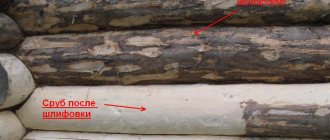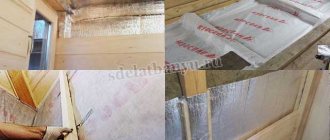Hello, dear readers!
Insulating a bathhouse, as you know, is a serious and important matter. It’s better to spend effort, time and money once than to spend hours later without getting the desired result. Insulation is carried out in different ways and materials, but for a bathhouse made of logs, there is a method proven over centuries.
It is based on sealing seams between logs, in the corners of a building, as well as in window and door openings. And this unique process is called caulking of a log house. The work is long, painstaking, but extremely necessary. But for those who are not going to do it themselves, at the end of the article I will give some coordinates...
Why do you need to caulk a bathhouse?
Craftsmen usually answer such a question simply - so that the log house does not rot or fall apart. Without a seal, a log box becomes a cold, eternally creaking hut. If you do not caulk the bathhouse and seal the seams hermetically, then the supporting surfaces of the crowns will rot in a year or two and the log house will simply “sit down” or fall on its side to the north.
In addition to choosing how to caulk a log bathhouse, it is important to do the job correctly, so we will try to understand the means, tools and rules for caulking a bathhouse.
For high-quality seam sealing you will need:
- Packaging jute, flax tow, proven over the years, or any other type of sealant with a fiber structure;
- A set of tools - a wooden hammer, a spatula, a wedge knife and a hook for stripping a seam or an electric groove;
- Brush with stiff bristles;
- Carpentry measurer.
Advice!
There are few tools, but they will all be needed for the job. The first time you can rent them. After your first practical experience, it will become clear how to properly caulk a bathhouse, then you can buy a good kit or make it yourself. If you want to seal the seams with sealant, fortunately there are quite a lot of different brands and types of them sold for bathhouse needs, then in this case no tool other than a nozzle gun for a tube with liquid polymer will be needed at all. It is possible and necessary to spray the joints with sealant for a log bathhouse in one day; the technology requires laying the paste-like mass in two passes with a difference of no more than four hours. Any disruption of the process can lead to peeling of the sealant, whereas caulking the frame of a bathhouse can be done in a couple of days with interruptions.
How to wind plumbing flax
The technology for winding sanitary flax (tow) is quite simple and looks like this:
- You must first prepare the surface on which the tow will be wound. If there was already another winding on the thread, then you need to completely clean the area with a metal brush.
- Using pliers, we make notches to better secure the flax during winding. (most modern fittings already have serrations on the threads).
- We take enough plumbing flax to end up with a long thin strand. We wind on the thread.
- It is necessary to wind plumbing flax (tow) onto the thread in the right direction - along the thread. If you have a right-hand thread, you need to wind the tow clockwise; if you are sealing gas connections with a left-hand thread, then the plumbing flax is wound counterclockwise. After the procedure, a special paste is applied to the sanitary linen, for example, from
- Finally, screw the fitting onto the thread, reliably sealing the threaded connection.
Important advice: sometimes, in order to find out how long it is worth screwing a fitting onto a thread, it is better to screw it on without first winding the plumbing flax, while counting the number of thread turns.
Choosing material for padding
Traditionally, seams and joints between wooden parts are sealed with a moisture-resistant, durable and necessarily easily deformable material. Interventional insulation for a bath can be made from:
- Synthetic polypropylene fibers, for example, in the form of a tape of woven and non-woven structure;
- Organic fiber, primarily jute cords and flax tow;
- Natural plant fibers from certain types of moss for baths.
For your information! Sometimes the problem arises of choosing whether moss or jute is better for a bathhouse, or they try to determine before starting work whether it is better to caulk with synthetics or organics. You need to choose based on the degree of shrinkage of the bathhouse frame and the size of the seam between the crowns.
Use Cases
Based on the name, you can understand that plumbing flax is used when connecting elements of water supply, gas pipelines or heating systems. These can be pipes, fittings, taps, various components and much more. However, according to the technical documentation, it can be used for other purposes.
In addition to the professional use of this material, it is also popularly used as environmentally friendly insulation for bathhouses, log houses and houses. Linen does not allow moisture to pass through, retains heat and does not allow air to pass through. There are also rare cases when it is used for sound insulation.
What is better, moss or tow for a bath?
Today, both materials are recognized as the most durable and reliable of all traditional fiber seals. In both cases, the decisive factor is not even the type, but the quality of the preparation of the material.
Moss is recognized by all craftsmen as a universal means for sealing crowns. Most often they try to caulk the bathhouse with red or white moss. Bunches of plants are prepared 2-3 weeks before the start of work. Before caulking the bathhouse, remove debris and dry the moss under a canopy, periodically turning over and shaking the layers.
The organic matter should remain slightly moist. After drying, the fibers turn into a springy and strong wire-like structure.
Caulking walls with moss is not difficult; you just need to correctly measure the amount of material and the force of hitting the shovel with a hammer. The easiest way is to caulk the seams immediately on the new log house, after assembling the walls of the bathhouse. After shrinkage, after a year and a half, the procedure will have to be repeated with the same material.
For your information! Often, craftsmen who undertake to caulk the walls of a bathhouse tell stories about the bactericidal properties of mosses, the ability of the plant to germinate and completely fill the gap between the crowns.
In fact, the seal can bloom and turn green only if the birds have collected seeds and grass in the spring. If you caulk with organic matter, the seal can easily become a source of problems, from the appearance of fungus to green sprouts. Therefore, you still need to be able to prepare the moss for the bathhouse for caulking. If it’s too dry, the material becomes brittle and doesn’t hold well in the gap; too wet moss is very difficult to caulk into the seam.
Plumbing tow: technical characteristics, winding on thread
Some people ask: what is best for sealing threads, fluoroplastic sealing material (FUM tape) or plumbing tow? This dispute has been going on for a long time, because it is impossible to give an exact answer.
For each specific type of procedure, its own material is suitable. And each product can be an excellent alternative to another. But the goal is the same - to make the connection airtight. Therefore, let's look at plumbing tow, its technical characteristics, as well as the process of winding it.
How difficult is it to caulk the walls of a bathhouse with tow?
Tow or combed flax fibers twisted into bundles are safer than moss or jute. Due to its soft and thin structure, working with linen material is more difficult than with any other sealants. Tow is convenient for caulking the seams on the walls of a rounded bathhouse. Interventional gaps on log buildings are too large, so the fiber has to be folded into several loops. Technologically, this does not affect the quality, but it can seriously delay the caulking process over time.
Flax tow, thanks to the small amount of non-drying oils remaining in the fabrics, has the best damping properties of all possible sealants, both natural and synthetic. Tow for a bath is very well suited for sealing corner locks, especially hand-cut ones. When shrinking, the bathhouse log does not make frightening creaks and sounds; the process itself occurs without any complications.
The only drawback is the low durability of flax fiber. In a log house, tow caulk will last up to 5 years; in a bathhouse, the fiber burns out in 2-3 years.
Order plumbing linen wholesale
carries out wholesale and retail trade, and is also a manufacturer of sanitary flax (tow), supplied to private plumbing stores and large DIY stores. We provide a detailed price list for the entire range, have ample options for payment and delivery, and also provide advice on any issue. Over the years, we have established partnerships with many stores and suppliers.
Our specialists will help you organize your own business and select the necessary products.
Still have questions? Call or write - we will answer. Phone: +7 E-mail Address: St. Petersburg, st. Zastavskaya, 5/1.
Jute fiber
Mechanically combed stems of jute hemp Jute Tassa produce a tough and at the same time durable fiber, which is used not only as a sealant on the walls of the bathhouse, it is an ideal material for containers and technical fabrics. Jute is produced in the form of coils, ribbons, and ropes, which allows you to caulk cracks on the walls of a bathhouse many times faster than using tow and moss.
Technical jute has only two disadvantages:
- High hygroscopicity;
- Susceptibility to rotting when soaked for a long time.
Jute for a bathhouse is interesting because during the shrinkage process it ideally fills the inter-crown space, especially if the log house is built from chopped logs. In this case, you only need to caulk with jute fiber and rope.
If, according to the project, the bathhouse building is planned to be covered with decorative finishing, the jute rope will simply rot in a couple of years. The tapes are laid to seal the crowns of the new log house; the rope is good for finishing the open surfaces of the walls of the bathhouse.
In fact, jute occupies an intermediate position between dense and hard moss and soft flax tow.
What kind of tow is there and how much does it cost?
According to its intended purpose, tow is divided into two types - the one intended for caulking, and the plumbing type. Since the material consumption in both cases is incommensurable, the volumes in which manufacturers sell tow cannot be compared.
Caulk is sold in bales of different weights or in rolls; plumbing tow is sold in small skeins. The cost of the material is low, but it can fluctuate between different manufacturers, since each of them has its own characteristics and differences, such as appearance (for many buyers this is important) and the presence of impregnation. The initial quality of the flax fiber from which the tow is made is of great importance. The price is usually set per kilogram, for bale tow it is at least 20-70 rubles, rolled tow costs from 48-80 rubles. Raw materials treated with resins are many times more expensive (about 300 rubles per 1 kg). A skein of plumbing tow can be bought for an average of 10 rubles.
Synthetic materials
In addition to natural fibers, you can caulk a bathhouse with more modern materials, for example, a composite cord consisting half of polypropylene threads and wool fibers. This type of caulking ensures strong retention of the seal even when the gap expands.
Caulking with synthetics is much more difficult; in addition, polypropylene burns out and crumbles under the influence of ultraviolet radiation, so for a bath it is best to use seals made of natural materials.
Advantages of using sanitary linen
Some experts now perceive tow for sealing threads as a material from the last century, but the vast majority successfully use it today. Why does it happen that modern materials are inferior to sanitary flax?
Everything is very simple! Firstly, sanitary tow is an environmentally friendly product, but even despite this, it has many advantages:
- With enough experience in owning tow, you will never see leaks. Occasionally, there are cases when a leak occurs in a cast iron thread where the flax is simply cut off. In other cases, the tow will swell and prevent the threaded connection from leaking;
- Plumbing tow is allowed for products made of both ferrous and non-ferrous metal.
- Plumbing flax is quite resistant to temperature changes. Regardless of the application, flax will not melt or burn out at high temperatures;
- Low cost compared to other sealing materials.
Seam filling technology
The process itself looks easy. In theory, it is necessary to caulk the crowns of a successfully constructed bathhouse twice, immediately after construction and upon completion of the shrinkage processes. In practice, caulking is done every three years, especially if the log has not been sanded and rounded.
First of all, before caulking the bathhouse, you need to inspect the seams, check and free the joint line from the old burnt-out seal. If the gaps in the inter-crown space of the bathhouse are supposed to be caulked with a cord or rope, then you will first need to measure the maximum drawdown of the crowns with a gauge.
This is done in order to determine the uniformity of shrinkage of the bathhouse building. If on one side the seal is pinched and compressed, and on the other it has fallen out of the cracks, then before caulking the box you need to determine the reasons for the uneven settling of the log house. At the same time, we specify the required thickness of the jute or flax hemp rope.
Necessary tools for work
So, we decided on the material. What else is needed for successful caulking of a log house? In addition to patience and perseverance, you need to use the right tool. Firstly, it’s a mallet, preferably a rubber one, but you can also use a wooden one. A regular hammer won't quite work. It is heavy and working with it in this case is not so convenient. A rubber mallet is the best choice.
You will also need metal spatulas. By the way, they are called caulking. They come in various sizes and configurations. The main requirement for such blades is the smoothness of the material; there should be no nicks on the metal. Otherwise, when the caulking is returned, the jute or felt will be pulled out of the cracks and seams.
The working part of the caulk should not be too sharp. Otherwise, the insulation will simply be cut. At this point you should pay attention.
It is best to use a rubber handle, since the work takes a long time and the blows from the mallet will become very noticeable to your hands over time. The feeling is not pleasant, but the rubber “absorbs” these impacts and brings a kind of comfort to work.
Many craftsmen mechanize such work on bath insulation. A hammer drill is used for these purposes. Switch it to chiselling mode, insert a special wide attachment and go ahead. The option is good, but requires electricity. There are times when he is simply not there. Thus, caulking a log house with a hammer drill is not applicable in all cases.
Sealing the material with tape
The easiest way to caulk a bathhouse is with a tape seal. After measuring the cracks, it becomes clear what width of tape should be used in this section of the log house. One end of the roll is secured in the gap at the corner, the sealing strip is carefully unrolled along the wall without twisting, a margin of 20-25 cm is left and cut off.
The ribbon laid out on the gap is carefully tucked into the gap so that the material does not sag or be stretched. Caulking begins from the widest edge, using a hammer and a wooden spatula with a rubber tip. The ribbon is pressed into the slot with light blows. It will be necessary to make 3-4 passes so that the sealant evenly and completely fits end-to-end between the crowns.
It will be necessary to caulk three or four pieces of tape before the desired joint seal can be achieved.
For your information! In this way, the cracks along the entire perimeter of the crown are sealed before it is possible to move to the next higher level.
If you caulk the entire wall at once, then one edge of the log house may rise by more than the thickness of the log, which will lead to the breakage of the upper rows of the bathhouse.
Tow for caulking
During construction, a product such as tow is used to fill the gap between the beams. This is most necessary when constructing wooden buildings. Tow is widely known for being easier and more reliable to use than the old version with natural moss.
Tow prevents shrinkage of the house, has hygroscopic properties and efficiently fills all kinds of gaps between the crowns.
Caulk joints of tow
The procedure for sealing the inter-crown space with bundles of fibers, such as tow or linen yarn, is a little more complicated. After cleaning the seam between the logs, the future place where the tow will be laid is rubbed with a mixture of formaldehyde, alcohol and linseed oil. You can impregnate individual cords with a disinfectant mixture before laying them in the wall of the bathhouse.
You need to caulk the bathhouse wall in the same sequence as when using tape. If the thickness of the seam is small, then the material can be laid by immediately rolling cords of 2-3 mm thick from the fiber. A tightly rolled roll of tow applied to the gap, without blows, is carefully pressed into the gap with a spatula.
For the next pass, roll up a thicker cord from tow, about 3-4 mm; this time you need to caulk the seam with force. For the last pass, a thick rope is rolled up, sometimes up to 8 mm. The material is hammered into the gap so that the edge protrudes above the line of the bathhouse crowns by no more than 3-4 mm.
If there are wide cavities between the crowns, they are caulked with additional ropes made of tow with a lubricant of any rubber-based elastic adhesive. In the same way, cracks in the logs of the bathhouse walls are clogged. The repaired areas are rubbed with additional acrylic paste.
Flaws
Despite all the advantages of using sanitary linen, it also has a number of disadvantages. Their most striking manifestation occurs in the case of improper installation or repair. After short-term use, rust may form, which will create inconvenience during dismantling.
In order to minimize defects as much as possible, we recommend using lubricants such as sealing pastes. Previously, craftsmen used red lead or drying oil for these purposes. Modern plumbing pastes significantly surpass these materials in their characteristics. They are safe for human health and prevent flax rotting and thread corrosion.











